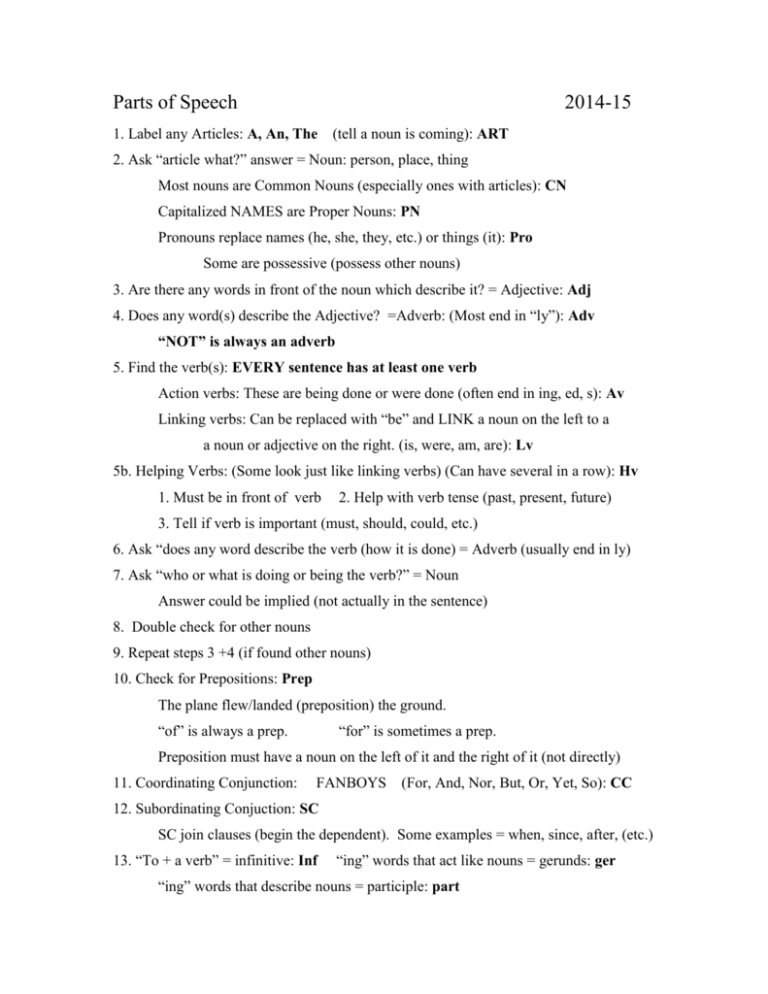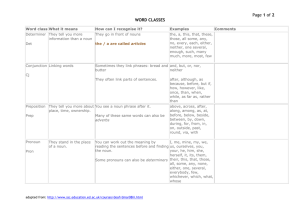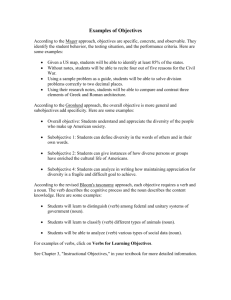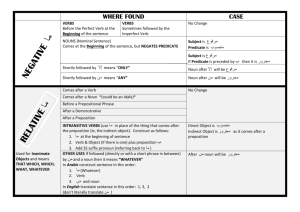Grammar Steps Complete
advertisement

Parts of Speech 2014-15 1. Label any Articles: A, An, The (tell a noun is coming): ART 2. Ask “article what?” answer = Noun: person, place, thing Most nouns are Common Nouns (especially ones with articles): CN Capitalized NAMES are Proper Nouns: PN Pronouns replace names (he, she, they, etc.) or things (it): Pro Some are possessive (possess other nouns) 3. Are there any words in front of the noun which describe it? = Adjective: Adj 4. Does any word(s) describe the Adjective? =Adverb: (Most end in “ly”): Adv “NOT” is always an adverb 5. Find the verb(s): EVERY sentence has at least one verb Action verbs: These are being done or were done (often end in ing, ed, s): Av Linking verbs: Can be replaced with “be” and LINK a noun on the left to a a noun or adjective on the right. (is, were, am, are): Lv 5b. Helping Verbs: (Some look just like linking verbs) (Can have several in a row): Hv 1. Must be in front of verb 2. Help with verb tense (past, present, future) 3. Tell if verb is important (must, should, could, etc.) 6. Ask “does any word describe the verb (how it is done) = Adverb (usually end in ly) 7. Ask “who or what is doing or being the verb?” = Noun Answer could be implied (not actually in the sentence) 8. Double check for other nouns 9. Repeat steps 3 +4 (if found other nouns) 10. Check for Prepositions: Prep The plane flew/landed (preposition) the ground. “of” is always a prep. “for” is sometimes a prep. Preposition must have a noun on the left of it and the right of it (not directly) 11. Coordinating Conjunction: FANBOYS (For, And, Nor, But, Or, Yet, So): CC 12. Subordinating Conjuction: SC SC join clauses (begin the dependent). Some examples = when, since, after, (etc.) 13. “To + a verb” = infinitive: Inf “ing” words that act like nouns = gerunds: ger “ing” words that describe nouns = participle: part Sentence Parts Simple predicate (sp) = the verb Simple subject (ss) = who or what did/be’d the verb (must be a noun) Complete Subject (single underline) = SS + other words about the SS Complete Predicate (double underline) = SP + anything else the SS did. Subordinating Conjunctions are NOT a part of either the subject or predicate. Coordinating Conjunctions that join clauses are NOT a part of either Prepositional phrase ( ) starts with preposition and ends with noun The “noun” is the Object of the Preposition (OP) Infinitive phrase [ ] Includes infinitive and the answer to: infinitive + what? Answer = Object of the Infinitive: OI Is the verb transitive? Note: all linking (state of being) verbs are intransitive To determine if an action verb is transitive: ask what’s verb? (may change verb tense to make it make sense) If answer is on right of verb and not in prep phrase = transitive If answer is on left (or no answer is obvious) = intransitive If verb is transitive there is a direct object.: DO Direct object is the answer “on the right” The direct object (DO) must be a noun (or act like a noun) The direct object cannot be in a prepositional phrase Indirect object? If there is a direct object there might be an indirect object (IO) To determine if there is one: Ask: Subject + verb + direct object + whom/what? If answer is a noun before the DO, that noun is the IO If verb is intransitive there might be a predicate nominative or adjective To find: Ask: subject +linking verb + what? Answer = noun = nominative: pn Answer = adjective = adjective: pa Appositive Noun which follows another noun and renames it (separated by commas) Clauses/Types/Purposes Every sentence has at least one “Independent” clause. Each clause must have a subject (implied is okay) and a predicate Every word in the sentence must be included in the clause EXCEPT a CC (when used to join clauses) If the sentence only has one verb it only has one clause = independent Dependent clauses: Subject and predicate but does not “stand alone” Would not make sense if that is all one said. Begins with subordinating conjunction or Relative pronoun Sentence Types: Simple: just one independent clause Compound: two or more independent clauses (and no dependent ones) Complex: one independent clause and one dependent clause Compound-complex: compound + at least one dependent Sentence Purpose: Declarative: normal sentence Imperative: ends with a period but makes a command Interrogative: asks a question (ends with a question mark) Exclamatory: ends in an exclamation point Diagrams Subject on the left. SS directly to left of intersecting line Predicate on the right. SP directly to right of intersecting line. Helping verbs may share the same line as the SP Direct Object follows non-intersecting perpendicular line (after the sp). Predicate adjectives/nominative follow slanted non intersecting line (after the sp) Slanted line means the verb is linking (intransitive) Prep Phrases (go down and over) Prep on slanted line Object of the prep on horizontal line Goes “down and over” Modifiers Go on slanted lines under the word modified. (articles, adjectives, poss pro, adv) Key Notes: 1. All sentences have a verb. 2. Generally speaking subject (noun) comes before the verb. 3. Articles are modifiers (come under the noun in the diagram) 4. Helping Verbs do not have their own diagram line (all other words do) 5. Conjunctions generally go on dotted lines in diagram. a. If a solid line is in middle of dotted connecter the conjunction is coordinating. 6. Subject/Predicate Steps SP – Verb SS – Noun doing it P – starts prep phrase OP – noun after the p – ends prep phrase DO – noun in predicate after an action verb (not in prep phrase) 7. One verb in sentence – One clause = Independent (simply bracket whole sentence) 8. Two intersections in diagram – two clauses = two verbs








